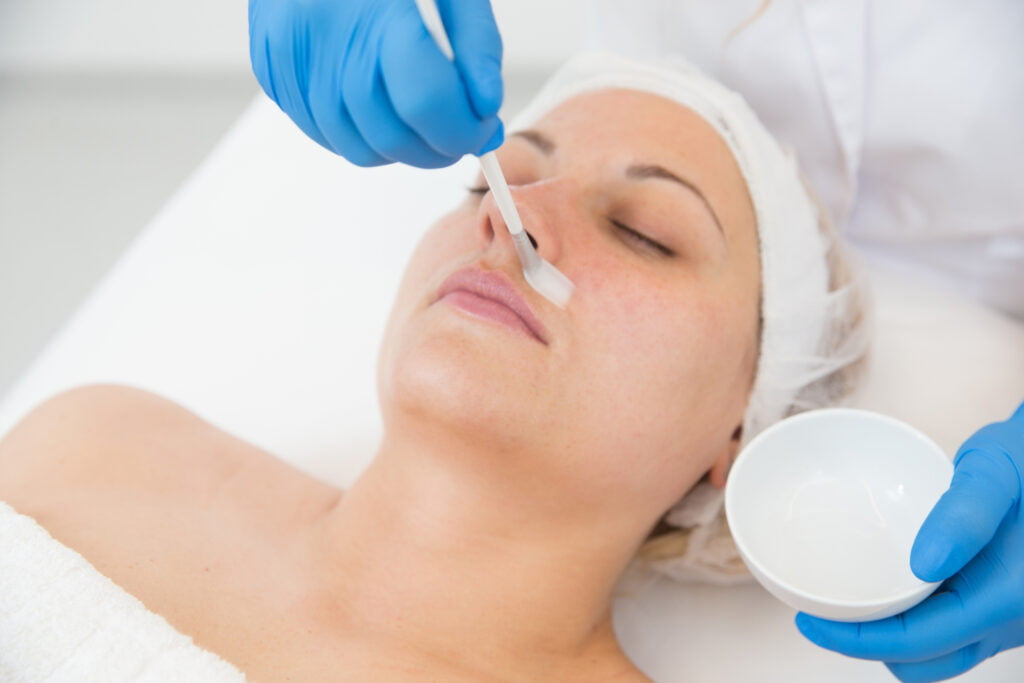Esthetician Shannon Answers Your Chemical Peel Questions

A chemical peel is one of our top treatment recommendations for patients who want to see quick, highly visible improvement in their skin concerns, from signs of aging to surface imperfections and blemishes. Here, Shannon O’Brien, our medical esthetician and chemical peel expert, answers FAQs about this transformative treatment that reveals more youthful, refreshed skin.
What is a chemical peel and how does it work?
A chemical peel is a minimally invasive treatment to improve skin texture and tone. We apply a specialized chemical solution to exfoliate away the dull, damaged top layers of skin. In most cases, the dead skin flakes off and the new, regenerated skin underneath is smoother, less wrinkled, and more even in tone.
What benefits can I expect from a chemical peel?
You can expect smoother skin texture and tone, diminished fine lines, fewer pigmentation irregularities, smaller-looking pores, and a reduced appearance of scars after a chemical peel. For a relatively simple procedure, the benefits of a chemical peel extend far beyond a short-term surface makeover: the exfoliation process increases collagen and elastin production to boost your skin’s long-term health and appearance.

Who is the best candidate for a chemical peel?
I recommend chemical peels to patients looking to address common skin concerns including fine lines, wrinkles, mild scarring, acne, age spots, or sun damage. Before moving forward with a chemical peel, we’ll discuss your skin’s history and your expectations to ensure it’s the best treatment option for you.
A chemical peel is safe and effective for most skin types and tones; however, patients with deeper skin tones must carefully select their provider to prevent post-treatment hyperpigmentation. Thankfully, we have other Philadelphia med spa treatments to consider if a chemical peel is not ideal for your skin tone or concerns.
What types of chemical peels are there?
Chemical peels come in three depths—light, medium, and deep:
- Light peels, such as glycolic, salicylic, or alpha-hydroxy acid, are superficial and gently exfoliate, requiring little to no downtime.
- Medium peels, like TCA (trichloroacetic acid), venture deeper to target fine lines, wrinkles, and pigment issues, with some downtime needed.
- Deep peels, such as phenol, penetrate several layers of skin deeply and offer dramatic results, correcting moderate lines, age spots, and freckles but require the most recovery time.
You may need multiple treatments with a light or medium peel to see the desired results.
How do I know which chemical peel is right for me?
I’ll examine your skin, discuss your concerns and goals, and explain which chemical peel would provide the best outcome for you. We’ll also discuss your lifestyle; sometimes, patients prefer a short series of light chemical peels to skip the downtime instead of committing to a few days of social downtime while their skin recovers after medium or deep peels.
A chemical peel offers your skin a fresh start for most skincare concerns at virtually any age.
What should I avoid before a chemical peel?
To ensure your skin is in prime condition to maximize the benefits of your peel, here are some key things you should avoid before your treatment:
- Sun exposure: Avoid unprotected UV exposure for at least two weeks before your peel.
- Certain skincare products: Pause products with active ingredients or exfoliating agents such as retinoids (like Retin-A), and products containing alpha hydroxy acids (AHAs), beta hydroxy acids (BHAs), or benzoyl peroxide at least one week before your peel.
- Waxing or laser hair removal: Avoid waxing, laser hair removal, or any other form of hair removal in the area to be treated for at least one week before your chemical peel.
- Facial treatments: Do not schedule any other facial treatments, including microdermabrasion or facials, at least one week before your peel, to avoid over-treating the skin.
Being mindful of these points helps prevent unexpected skin irritation or potentially adverse reactions to the peel. Depending on the type of peel you choose, there may be other pre-peel instructions added to this list.
What should I expect during and after the treatment?
During the treatment, I’ll cleanse your skin and apply one or more chemical solutions. You may feel a tingling, stinging, or slight burning sensation for a few minutes—more so during deeper peels. We can apply cooling compresses or use cool air to help lessen temporary discomfort. Your treatment can take anywhere from a few minutes to over an hour, depending on the type of peel.
Post-treatment, your skin’s reaction depends on the peel’s depth. Light peels may cause minor irritation and redness, while medium and deeper peels may produce more pronounced redness and peeling for several days or weeks. I will explain what you’ll experience based on your peel so there are no surprises.
How long is the recovery time after a chemical peel?
Light peels may take 1-7 days for the skin to heal completely, although you’ll typically be able to be out and about like normal. Medium peels may take 7-14 days, with some mild, residual redness lasting up to a month. Deep peels require 2+ weeks for the skin to recover, due to the more extensive exfoliation. Expect to see the full benefits of your peel as the new skin emerges once healing is complete.
How should I care for my skin after a chemical peel?
Aftercare instructions are tailored based on your treatment, but general guidelines include gently cleansing the skin, avoiding sun exposure, and wearing broad-spectrum sunscreen daily. You mustn’t pick at or peel off dead skin—allow this process to happen naturally. Manually peeling off flaking skin can cause hyperpigmentation or other damage to your appearance!
How often can I have a chemical peel?
Light peels can be done every 4-6 weeks until we achieve optimal results, while medium peels might be performed every 6 to 12 months. You can schedule a maintenance peel as needed once your initial treatment series is complete.
Deep peels are not commonly performed with regularity due to their intensity—many patients with severe skin concerns typically receive 1 deep peel to start and then transition to medium and light peels to improve initial results without having a longer recovery period. We’ll discuss how often you should schedule your treatments once we see how your skin responds.
Can chemical peels be combined with other treatments?
Absolutely; combining multiple treatment modalities can achieve more transformative skin rejuvenation in less time without extending recovery. Here are some of the treatments we can add to your treatment plan:
The success of combining treatments relies on timing each procedure to receive the most benefits without over-treating the skin. If you’re interested in enhancing the effects of your chemical peels with other treatments, I would be happy to design the optimal treatment plan for you.
Refresh and renew your skin at Claytor Noone Plastic SurgeryTo schedule your chemical peel with Shannon or learn more about your non-surgical options at our Bryn Mawr med spa, call us at 610-527-4833 or fill out the contact form at the bottom of this page.
Philadelphia board-certified plastic surgeon Dr. Brannon Claytor works closely with our med spa team to ensure you experience outstanding care and results.
